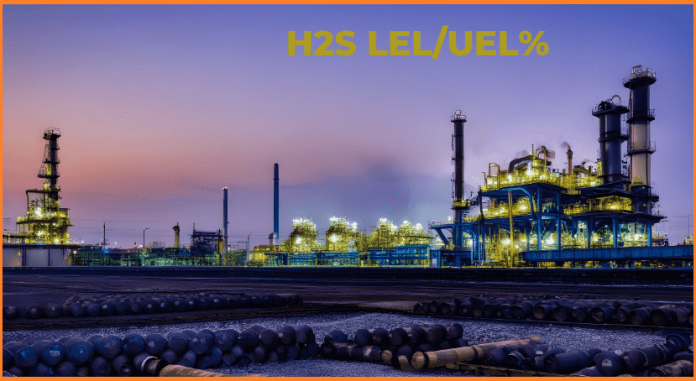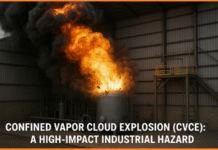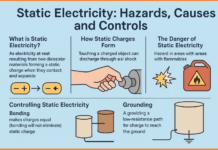Hydrogen sulfide (H2S) is a colorless and highly toxic gas with a distinctive rotten egg odor. It is commonly found in various industrial processes, such as oil and gas production, wastewater treatment, and chemical manufacturing. It is very important to understand the concepts of Lower Explosive Limit (LEL) and Upper Explosive Limit (UEL) when working with H2S, as they help ensure safety in potentially hazardous environments.
Contents
Lower Explosive Limit (LEL) of H2S Gas – 4.3 %
The Lower Explosive Limit, or LEL, refers to the minimum concentration of H2S in air required for it to ignite and sustain combustion. It indicates the lower boundary of the flammable range. Below the LEL, the gas-air mixture is too lean to burn. The LEL of H2S is typically around 4.3% by volume, meaning that any concentration below this threshold is considered too low to support combustion.
It is important to note that the LEL can vary depending on the specific conditions, sources of ignition, and other factors. Thus, it is crucial to regularly monitor and measure the concentration of H2S in the environment to ensure safety and prevent potential explosions or fires.
Upper Explosive Limit (UEL) of H2S Gas – 45%
The UEL represents the maximum concentration of H2S in air at which it can ignite and sustain combustion. Concentrations higher than the UEL are considered too rich to burn. The UEL of H2S is typically around 45% by volume.
Maintaining the H2S concentration below the UEL is critical to prevent the risk of explosions. If the concentration exceeds the UEL, the gas-air mixture becomes too rich, leading to an increased likelihood of combustion and potential hazards.
Importance of Monitoring LEL and UEL of H2S Gas
LEL and UEL of H2S is very important for assessing the flammability hazards associated with this gas. Monitoring the gas concentration in the environment, along with implementing appropriate safety measures, can help prevent accidents, protect workers, and ensure compliance with safety regulations.
To monitor the concentration of H2S, various gas detection instruments, such as portable gas detectors and fixed gas monitoring systems, are used. These devices provide real-time measurements and alarms to warn workers and prompt necessary actions if the gas concentration approaches or exceeds the flammable range.
It is also essential to have proper ventilation systems in place to control the H2S concentration within safe limits. Adequate ventilation helps maintain a safe working environment and minimize the risk of H2S-related incidents.
Hydrogen sulfide (H2S) is a hazardous gas that poses serious risks to human health and safety. Understanding the concepts of Lower Explosive Limit (LEL) and Upper Explosive Limit (UEL) is very important when working with H2S. Monitoring the gas concentration, implementing safety measures, and adhering to regulations are essential to prevent accidents and protect lives. By paying attention to LEL and UEL, we can mitigate the potential hazards associated with H2S and ensure a safer working environment.
PROPERTIES of H2S
| Chemical Formula | H2S |
| Molecular Weight | 34.08. |
| CAS No. | 7783-06-4. |
| UN No. | 1053. |
| Physical Properties | Colorless flammable gas with a strong offensive odor of rotten eggs. It is heavier than air and settles on the ground. |
| Boiling Point | –60.4°C. |
| Melting Point | –85.53°C |
| Specific Gravity | (18°C/4°C)—1.54. |
| Vapour Density (Air =1) | 1.189 |
| Density of Saturated Liquid | 774 kg/m3 at 21.1°C. |
| Density of Saturated Vapour | 31.04 kg/m3 at 21.1°C. |
| Vapour Pressure | 20 atm at 25°C. |
| Critical Temperature | 100.4°C. |
| Critical Pressure | 88.9 atm. |
| Critical Density | 349 kg/m3. |
| Solubility | Slightly soluble in cold water, 0.32 percent maximum at 26.67°C (m/m), more soluble in alcohol. |
| Auto Ignition Temperature in Air | 260°C. |
| Flammable Limits in Air (Percent by Volume) at 20°C: | Lower explosion limit (LEL) : 4.3 Upper explosive limit (UEL) : 46 |
| Toxicity | Threshold Limit Value (TLV)—10 ppm (15 mg/m3) (ACGIH). |
Remember, safety should always be the highest priority when dealing with any toxic or flammable substances.
H2S LEL and UEL FAQ
Q: What does LEL stand for in relation to H2S?
A: LEL stands for Lower Explosive Limit. In the context of H2S, it refers to the minimum concentration of H2S in air needed to ignite and sustain combustion.
Q: What is the typical LEL of H2S?
A: The Lower Explosive Limit (LEL) of H2S is typically around 4.3% by volume. Any concentration below this threshold is considered too low to support combustion.
Q: What is UEL in relation to H2S?
A: UEL stands for Upper Explosive Limit. It represents the maximum concentration of H2S in air at which it can ignite and sustain combustion.
Q: What is the typical UEL of H2S?
A: The Upper Explosive Limit (UEL) of H2S is typically around 45% by volume. Concentrations higher than this are considered too rich to burn.
Q: Why is it important to monitor LEL and UEL for H2S?
A: Monitoring the LEL and UEL of H2S is crucial for assessing the flammability hazards associated with this gas. It helps to prevent potential explosions, protect workers, and ensure compliance with safety regulations.
Q: How can LEL and UEL be monitored for H2S?
A: Gas detection instruments, such as portable gas detectors and fixed gas monitoring systems, are used to monitor the concentration of H2S in the environment. These devices provide real-time measurements and alarms to warn workers if the gas concentration approaches or exceeds the flammable range.
Q: What happens if H2S concentration exceeds the UEL?
A: If the concentration of H2S exceeds the Upper Explosive Limit (UEL), the gas-air mixture becomes too rich to ignite. This can lead to an increased likelihood of combustion and potential hazards.
Q: What precautions should be taken when working with H2S?
A: When working with H2S, it is essential to implement proper safety measures, such as using personal protective equipment, providing adequate ventilation, and following established protocols for handling the gas. Regular monitoring of gas concentrations and employee training in H2S safety are also crucial.
Q: Can H2S be detected by human senses alone?
A: H2S gas has a distinctive rotten egg odor, which can be detected by some people at low concentrations. However, relying solely on the sense of smell is not sufficient, as high concentrations of H2S can quickly overcome the sense of smell and pose significant health risks. Therefore, using accurate gas detection instruments is recommended.
Q: Are there legal limits for H2S concentration?
A: Yes, legal limits for H2S concentration vary by country and industry. It is crucial to comply with the applicable regulations and standards to ensure the safety of workers and the environment.
Remember, maintaining a safe working environment and adhering to proper safety practices is essential when working with H2S or any hazardous substance.





